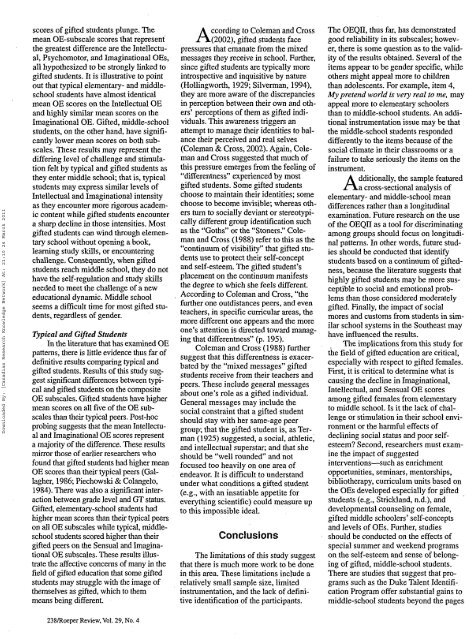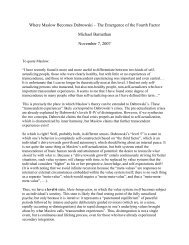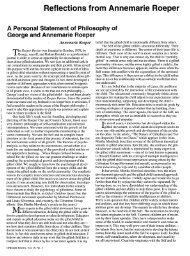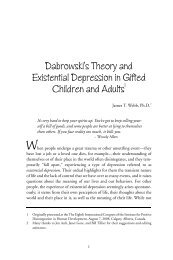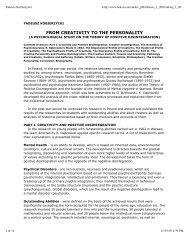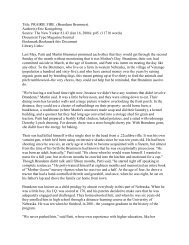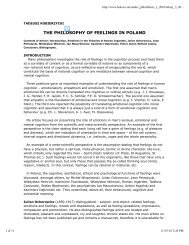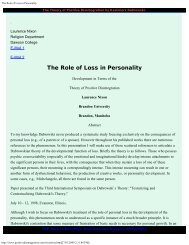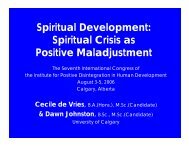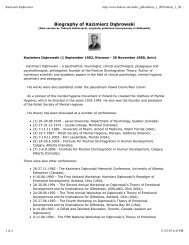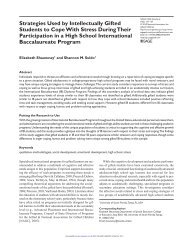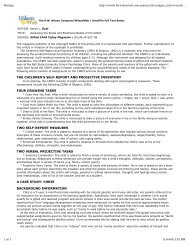Patterns of Overexcitability Overexcitabilities - Kazimierz ...
Patterns of Overexcitability Overexcitabilities - Kazimierz ...
Patterns of Overexcitability Overexcitabilities - Kazimierz ...
You also want an ePaper? Increase the reach of your titles
YUMPU automatically turns print PDFs into web optimized ePapers that Google loves.
Downloaded By: [Canadian Research Knowledge Network] At: 21:10 26 March 2011scores <strong>of</strong> gifted students plunge. Themean OE-subscale scores that representthe greatest difference are the Intellectual,Psychomotor, and Imaginational OEs,all hypothesized to be strongly linked togifted students. It is illustrative to pointout that typical elementary- and middleschoolstudents have almost identicalmean OE scores on the Intellectual OEand highly similar mean scores on theImaginational OE. Gifted, middle-schoolstudents, on the other hand, have significantlylower mean scores on both subscales.These results may represent thediffering level <strong>of</strong> challenge and stimulationfelt by typical and gifted students asthey enter middle school; that is, typicalstudents may express similar levels <strong>of</strong>Intellectual and Imaginational intensityas they encounter more rigorous academiccontent while gifted students encountera sharp decline in those intensities. Mostgifted students can wind through elementaryschool without opening a book,learning study skills, or encounteringchallenge. Consequently, when giftedstudents reach middle school, they do nothave the self-regulation and study skillsneeded to meet the challenge <strong>of</strong> a neweducational dynamic. Middle schoolseems a difficult time for most gifted students,regardless <strong>of</strong> gender.Typical and Gifted StudentsIn the literature that has examined OEpatterns, there is little evidence thus far <strong>of</strong>definitive results comparing typical andgifted students. Results <strong>of</strong> this study suggestsignificant differences between typicaland gifted students on the compositeOE subscales. Gifted students have highermean scores on all five <strong>of</strong> the OE subscalesthan their typical peers. Post-hocprobing suggests that the mean Intellectualand Imaginational OE scores representa majority <strong>of</strong> the difference. These resultsmirror those <strong>of</strong> earlier researchers wh<strong>of</strong>ound that gifted students had higher meanOE scores than their typical peers (Gallagher,1986; Piechowski & Colangelo,1984). There was also a significant interactionbetween grade level and GT status.Gifted, elementary-school students hadhigher mean scores than their typical peerson all OE subscales while typical, middleschoolstudents scored higher than theirgifted peers on the Sensual and ImaginationalOE subscales. These results illustratethe affective concerns <strong>of</strong> many in thefield <strong>of</strong> gifted education that some giftedstudents may struggle with the image <strong>of</strong>themselves as gifted, which to themmeans being different.According to Coleman and Cross(2002), gifted students facepressures that emanate from the mixedmessages they receive in school. Further,since gifted students are typically moreintrospective and inquisitive by nature(Hollingworth, 1929; Silverman, 1994),they are more aware <strong>of</strong> the discrepanciesin perception between their own and others'perceptions <strong>of</strong> them as gifted individuals.This awareness triggers anattempt to manage their identities to balancetheir perceived and real selves(Coleman & Cross, 2002). Again, Colemanand Cross suggested that much <strong>of</strong>this pressure emerges from the feeling <strong>of</strong>"differentness" experienced by mostgifted students. Some gifted studentschoose to maintain their identities; somechoose to become invisible; whereas othersturn to socially deviant or stereotypicallydifferent group identification suchas the "Goths" or the "Stoners." Colemanand Cross (1988) refer to this as the"continuum <strong>of</strong> visibility" that gifted studentsuse to protect their self-conceptand self-esteem. The gifted student'splacement on the continuum manifeststhe degree to which she feels different.According to Coleman and Cross, "thefurther one outdistances peers, and eventeachers, in specific curricular areas, themore different one appears and the moreone's attention is directed toward managingthat differentness" (p. 195).Coleman and Cross (1988) furthersuggest that this differentness is exacerbatedby the "mixed messages" giftedstudents receive from their teachers andpeers. These include general messagesabout one's role as a gifted individual.General messages may include thesocial constraint that a gifted studentshould stay with her same-age peergroup; that the gifted student is, as Terman(1925) suggested, a social, athletic,and intellectual superstar; and that sheshould be "well rounded" and notfocused too heavily on one area <strong>of</strong>endeavor. It is difficult to understandunder what conditions a gifted student(e.g., with an insatiable appetite foreverything scientific) could measure upto this impossible ideal.ConclusionsThe limitations <strong>of</strong> this study suggestthat there is much more work to be donein this area. These limitations include arelatively small sample size, limitedinstrumentation, and the lack <strong>of</strong> definitiveidentification <strong>of</strong> the participants.The OEQII, thus far, has demonstratedgood reliability in its subscales; however,there is some question as to the validity<strong>of</strong> the results obtained. Several <strong>of</strong> theitems appear to be gender specific, whileothers might appeal more to childrenthan adolescents. For example, item 4,My pretend world is very real to me, mayappeal more to elementary schoolersthan to middle-school students. An additionalinstrumentation issue may be thatthe middle-school students respondeddifferently to the items because <strong>of</strong> thesocial climate in their classrooms or afailure to take seriously the items on theinstrument.Additionally, the sample featureda cross-sectional analysis <strong>of</strong>elementary- and middle-school meandifferences rather than a longitudinalexamination. Future research on the use<strong>of</strong> the OEQII as a tool for discriminatingamong groups should focus on longitudinalpatterns. In other words, future studiesshould be conducted that identifystudents based on a continuum <strong>of</strong> giftedness,because the literature suggests thathighly gifted students may be more susceptibleto social and emotional problemsthan those considered moderatelygifted. Finally, the impact <strong>of</strong> socialmores and customs from students in similarschool systems in the Southeast mayhave influenced the results.The implications from this study forthe field <strong>of</strong> gifted education are critical,especially with respect to gifted females.First, it is critical to determine what iscausing the decline in Imaginational,Intellectual, and Sensual OE scoresamong gifted females from elementaryto middle school. Is it the lack <strong>of</strong> challengeor stimulation in their school environmentor the harmful effects <strong>of</strong>declining social status and poor selfesteem?Second, researchers must examinethe impact <strong>of</strong> suggestedinterventions—such as enrichmentopportunities, seminars, mentorships,bibliotherapy, curriculum units based onthe OEs developed especially for giftedstudents (e.g., Strickland, n.d.), anddevelopmental counseling on female,gifted middle schoolers' self-conceptsand levels <strong>of</strong> OEs. Further, studiesshould be conducted on the effects <strong>of</strong>special summer and weekend programson the self-esteem and sense <strong>of</strong> belonging<strong>of</strong> gifted, middle-school students.There are studies that suggest that programssuch as the Duke Talent IdentificationProgram <strong>of</strong>fer substantial gains tomiddle-school students beyond the pages238/Roeper Review, Vol. 29, No. 4


